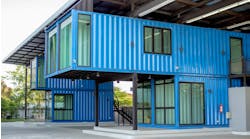Latest from Best Practices
Plumbing and the Future of Modular Construction
Sponsored
Retrofitting Older Buildings with Modern Plumbing Systems
Retrofitting older buildings with modern plumbing systems is a complex but essential endeavor to ensure functionality, compliance with current codes and sustainable performance. Historical buildings often come with aging infrastructure that fails to meet the demands of modern water usage, energy efficiency standards and health safety regulations.
Successfully upgrading these systems requires careful planning, adherence to evolving codes and strategic implementation of advanced technologies.
Understanding Structural Constraints
Due to their original construction materials, layouts and design intents, older buildings present unique challenges. For instance, retrofitting structures built with lead or galvanized steel pipes necessitates complete system replacement to meet health and safety standards outlined by organizations like the Environmental Protection Agency (EPA).
Additionally, these buildings often lack adequate space for modern plumbing configurations, demanding innovative design solutions like manifold systems or vertical stack plumbing to optimize efficiency without significant structural alterations.
Adherence to Modern Codes and Standards
Plumbing retrofits must comply with current codes such as the International Plumbing Code (IPC) and the National Standard Plumbing Code (NSPC). These codes include guidelines on water efficiency, material standards and system safety.
The latest NSPC revisions incorporate provisions for efficient water use and address the risks of Legionella growth by including standards for temperature control and system design. Staying current with such codes ensures the retrofit aligns with functional and regulatory expectations.
The Role of Pressure Regulation in Retrofitting
Pressure regulation is a critical consideration in retrofitting older buildings. Many historical plumbing systems cannot handle the improved water pressure that comes with modern systems. Excessive pressure can cause leaks, pipe bursts or premature wear on fixtures. Installing pressure-reducing valves (PRVs) can help mitigate these risks.
Integrating Water Conservation Technologies
Water conservation is a primary focus of modern plumbing systems. Retrofitting efforts can leverage low-flow fixtures, dual-flush toilets and advanced flow restrictors to reduce water consumption.
Building owners may also benefit from implementing Water Demand Calculators, now part of the NSPC, to size plumbing systems accurately and avoid over-specification, which can lead to inefficiency and increased costs. Greywater recycling systems and rainwater harvesting technologies can further enhance sustainability in retrofits.
Addressing Drainage Challenges in Aging Systems
Older buildings often have insufficient or poorly designed drainage systems, leading to recurring blockages and slow water flow. Retrofitting provides an opportunity to replace undersized drainpipes or introduce innovations such as dual-purpose storm and sanitary sewer systems.
Where trenching is impractical, pipe-bursting or cured-in-place pipe (CIPP) technologies can modernize drainage lines with minimal structural disruption. These methods are particularly effective in urban retrofits, where preserving existing landscapes or pavements is critical.
Prioritizing Energy Efficiency
Hot water systems in older buildings are often outdated, resulting in high energy consumption and thermal inefficiencies. Retrofitting these systems with tankless water heaters, modulating-condensing boilers, heat pump water heaters or solar thermal systems can significantly reduce energy costs.
These upgrades should consider pipe insulation and recirculation systems to minimize heat loss and water waste. Energy modeling tools can assist in predicting performance outcomes and optimizing system design during the planning phase.
Ensuring Boiler Efficiency in Retrofitted Systems
When retrofitting older buildings, addressing boiler efficiency is essential for hydronic heating systems and industrial applications. Scale buildup and corrosion are two major threats to boiler performance. Even minimal scale deposits — less than ⅛ inch — can reduce boiler efficiency by 15%, significantly increasing energy costs and operational stress.
Mitigating these issues involves proactive chemical treatments. Scale inhibitors—such as polymers and phosphates—prevent mineral deposits by neutralizing hardness, allowing solid particles to be flushed out before they adhere to surfaces.
Meanwhile, oxygen scavengers like sulfites or tannins reduce corrosion by eliminating dissolved oxygen, which reacts with the boiler’s metal surfaces to form rust. These measures enhance energy efficiency and extend the operating life of boilers, making them a critical consideration in any retrofitting plan.
Minimizing Health Risks in Plumbing Retrofits
Health risks associated with older plumbing systems—such as lead contamination and bacterial growth—must be addressed during retrofits. Replacing lead pipes and fixtures—as required by the Safe Drinking Water Act—is a baseline measure.
Additionally, retrofitting plans should consider the risks of Legionella bacteria, particularly in hot water systems. Advanced water treatment methods, such as ultraviolet (UV) disinfection or copper-silver ionization, can be integrated to reduce microbial risks. Proper system flushing and monitoring post-installation are essential for maintaining long-term water quality and user safety.
Tackling Accessibility and Maintenance Issues
Older plumbing systems are notorious for inaccessibility, making maintenance challenging. Retrofitting offers an opportunity to reroute or reorganize plumbing lines to facilitate easier access for repairs and upgrades. Transitioning to materials like PEX or copper improves durability and reduces maintenance requirements.
Advanced Monitoring and Automation
Integrating Internet of Things (IoT) technologies can enhance the functionality and efficiency of retrofitted plumbing systems. Smart sensors, leak detection devices, and automated shut-off valves provide real-time monitoring and quick responses to issues, reducing water damage risks and system downtime.
Additionally, water quality sensors can ensure compliance with safety standards by monitoring for contaminants and system performance issues.
Planning for Future-Proof Systems
Future-proofing retrofitted plumbing systems is essential for long-term performance. This involves designing adaptable systems that can accommodate changes in building use, regulations or technology. For example, integrating modular components allows for easy upgrades or expansions without major disruptions.
Additionally, compliance with emerging standards—such as those in the Water Efficiency and Sanitation Standard (WE•Stand)—ensures retrofitted systems remain relevant as codes evolve. Implementing building information modeling (BIM) during the design phase can help predict future challenges and streamline maintenance and upgrades.
Cost-Benefit Analysis of Plumbing Retrofits
Plumbing retrofits in older buildings often involve significant upfront costs, but the long-term benefits outweigh the investment. Reduced water and energy bills, improved system reliability and enhanced property value are among the key advantages. The EPA highlights that structures implementing energy efficiency technologies into their water systems can reduce consumption by up to 30%.
Additionally, retrofits addressing health risks can reduce liability and enhance tenant satisfaction, particularly in commercial or residential properties. Detailed cost-benefit analyses—considering both tangible and intangible returns—are essential for stakeholders to make informed decisions.
A Strategic Approach to Retrofitting
Retrofitting older buildings with modern plumbing systems requires balancing historical integrity and contemporary efficiency standards. Strategic planning, compliance with updated codes and leveraging advanced technologies can transform outdated infrastructure into high-performing, sustainable systems.
Collaboration with skilled professionals ensures a seamless integration of modern solutions while addressing the unique challenges of historical structures. Proper retrofitting modernizes functionality and extends these buildings' life span and value, making them viable for decades to come.
Ellie Gabel is a freelance writer as well as an associate editor for Revolutionized.com. She specializes in covering the latest innovations in science and tech for an audience of industry professionals. When she's not busy writing, you can find her spending quality time with her husband and their cats.


